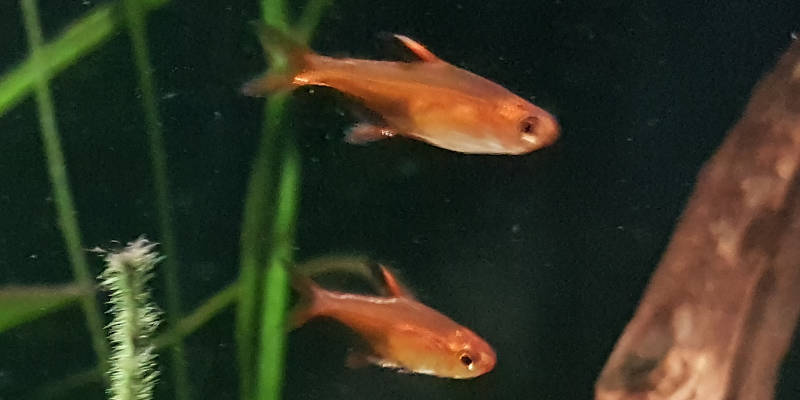Ember tetras are a bright orange and peaceful nano fish which can make a great addition to your aquarium. They are inquisitive and usually occupy the middle region of the tank and enjoy swimming among plants.
About Ember Tetras
Ember Tetras (Hyphessobrycon amandae) are a small bright orange tetra from the amazon basin region of South America. They are one of the smallest tetras and only grow to around 2cm (0.8 inches).
Ember Tetra Profile
Origin: Amazon basin region of South America.
Size: 0.8 inches (2cm)
Minimum tank size: 10 gallons (38 litres) or more.
Tank region: Spend majority of their time in the middle to upper region of the tank.
Water temperature: 21 to 28 °C (70 - 82 °F)
Water conditions: Neutral slightly acidic water with PH between 5 to 7 is desirable.
Difficulty to keep: Easy
Ember Tetra - Behaviour and Personality
Ember Tetras like many other tetra species are interesting little fish. They are inquisitive and usually occupy the middle region of the water and enjoy swimming among plants. I find the bright orange of Ember Tetras adds a great spark of colour to a planted tank.
In a 10 gallon aquarium you could easily have a school of 15 Ember Tetras, which would look fantastic!

Aquarium Setup
Ember Tetras appreciate a planted aquarium and will often school in the shadows provided by large plants such as amazon swords.
The aquarium will need the standard equipment for a freshwater tropical tank. An established filter, aquarium heater and lighting.
Suitable Tank Mates for Ember Tetras
Other peaceful fish make the best tank mates for Ember Tetras. Other tetras are good choices but also consider fish which occupy other areas of the tank. For example, dwarf cichlids, cory catfish and plecos which occupy the bottom region of the tank also make good tank mates.
Ember Tetras are not "fin nippers" which also make them suitable tank mates for Betta Splendens.
Ember Tetras should not be kept with large fish such as Angle Fish who could easily eat your Ember Tetras!
Ember Tetras make great dither fish. Having dither fish help other fish feel comfortable and less stressed.
What to Feed Ember Tetras
As Ember Tetras are small they require small foods. Live baby brine shrimp are a great choice alternatively frozen baby brine shrimp are also good. High quality flake or pallet foods can also be given but I recommend sticking with high quality brands such as Hikari.

Breeding Ember Tetras
Ember tetras are egg scatterers and do not care for or rear fry in any way.
The breeding behaviour is as follows: The female will swim into a densely planted area or another area with dense cover such as leaf little and release her eggs. Males will follow to fertilise the eggs.
As ember tetras are so small raising fry can be difficult. In most cases fry will initially feed off micro-organisms in the tank such as on mosses and other plants.
The process of breeding Ember Tetras is the same for other egg scatterers.
- Start by ensuring the fish are health and in good condition. Feeding live food such as baby brine shrimp in the lead up to breeding can help.
- Set up a breeding tank with aquarium water from an existing tank. On the bottom of the tank place spawning mops or glass marbles. This is so that any released eggs which fall to the bottom of the tank will l fall into the cracks and not get eaten.
- On top of the spawning mops place clumps of java moss (or other similar moss), this will provide a protected area for the Ember Tetras to swim into and spawn.
- The water should be close to neutral (7 Ph) and on the warmer side, 27 degrees C. No light is required, it is best to keep the breeding tank dimly lit and I find a little bit of ambient light to be sufficient.
- A small air powered sponge filter should be used for filtration which will also oxygenate the water.
- Place the group of Ember Tetras (1 or 2 males with many females) into the breeding tank for 48 hours to allow them to breed. After 48 hours remove them and return them to their original tank.
- After an additional 24 to 48 hours the first fry should be visible.
Conclusion
Ember Tetras are easy to keep and despite their small size can provide a bright orange spark to your aquarium. They are best kept in a school of 10 or more and they prefer a well planted aquarium.



